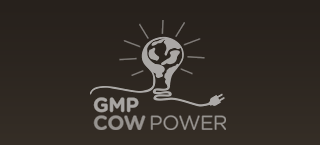Yes, we know our cows. Part of our job is growing the highest quality feed we possibly can in order to provide these hard working girls with a balanced, nutritious diet. We have enormous investments in equipment, labor, seed and land to grow the grass and corn which provides the bulk of the cows’ nutritional needs.
Having a digester allows us to capitalize on our huge feed investments by collecting the leftovers that the cows don’t utilize as part of their natural digestion, otherwise known as manure. Our barns are open and airy. The cows have free access to fresh feed, clean beds and water. A slow moving scraper that looks like a squeegee on wheels is constantly moving across the soft rubber coated barn floors collecting this liquid gold.
We’re proud to be the first Cow Power farm in Vermont, and invite you to learn how this innovative, renewable energy system works.
All the waste from the farm is collected and pumped into a biodigester. The biodigester looks like a concrete in-ground swimming pool with a concrete cover. Using excess heat from the generator, we keep the digester the same temperature as a cow – simply continuing what was happening in the cows’ stomachs. The 16 foot deep digester is filled up to 14 feet with manure, allowing the naturally occurring methane gasses to collect at the top.
That methane gas is used to power generators that push enough electricity onto the grid for about 300+ homes. And as good as that is, it is not even the best part for our farm – the manure that comes out of the digester is even more valuable than when it came in! Throughout each day, the freshest manure pushes the older manure around in the plug-flow digester system. After this 21 day cycle, the manure is pumped out of the digester and goes through a mechanical separator that squeezes the liquid apart from the undigested plant fibers. These plant fibers, having been cooked in the digester at 100 degrees for 21 days are the consistency of peat moss, and we used them as a comfortable, fluffy bedding for our cows – replacing a tractor-trailer load of sawdust each week. This contributes to our carbon reduction simply by keeping a tractor-trailer off the road to our farm and by reducing our trips to the fields to spread that amount of sawdust with our manure-based fertilizer. Because we have plenty of bedding, we use more than ever, keeping our cows extra comfortable. For our family it’s always all about the cows; their comfort, nutrition and health. We use 1/2 of these separated plant fibers; the rest is sold to other farms for bedding, and to gardeners and landscapers as a nutrient rich, weed seed free, fertilizer.
After we separate the bedding fibers, the remaining liquids are stored in our manure pit until we can use them as an improved liquid fertilizer that is applied to the fields with an aerator ,or directly onto the growing hay crops – effectively reducing potential for run off and reducing our need to purchase commercial, fossil fuel-based, fertilizers. The aerator application uses a piece of equipment to poke small holes into the ground, injecting the valuable liquid nutrients like nitrogen, phosphorous and potassium directly into the soil at the root level. The liquid manure is pumped from our storage area through a hose that can go up to two miles, eliminating hundreds of hours of manure trucks on the road and on our fields, further reducing our carbon foot print and reducing soil compaction.
Another interesting fringe benefit of our renewable energy project comes from harnessing the excess heat from the methane-powered generator. Excess heat is captured through a heat exchanger, and used to keep the digester at 100 degrees, along with providing hot water to the farm for the daily cleaning of the milking system, and for radiant floor heat in the office and milking parlor in the winter. Intelligently utilizing the excess heat saves us an expense while further reducing our carbon footprint by reducing use of fossil fuels.
And because we simply just can’t stand to throw anything away, the used oil from the generator is utilized to run a waste oil furnace that heats our farm equipment repair shop.
This entire process, affectionately called “Cow Power,” allows us to be better neighbors by reducing farm odor, reducing our carbon footprint, removing methane emissions from the air, and generating electricity for our fellow Vermonters. With a Cow Power project, there are no fossil fuels consumed to make energy, therefore, the carbon released from our generators is considered global warming neutral. GMP Cow Power has touted Cow Power as their most consistent source in their renewables portfolio. We couldn’t agree more – our cows are very reliable, and we can count on them to provide fuel 24/7!
People are always asking us “why don’t all farmers do this?” Many of us in the dairy industry believe that any size farm can build a digester, and eventually most will. The barriers are the sizeable initial investments, and locking in a reliable revenue from the power sales. Operating a Cow Power facility also requires new skills, and more labor. But when a community gets together, these challenges can be met.
Our renewable energy project is a partnership between the farm, the utility and the community, utilizing an existing waste stream, protecting the environment and providing added value products for both, the farm and community.
Cow Power goes a long way to ensure social, environmental and economic sustainability for the future of our farm. Dairy farming is all-consuming, hard work, and we are fortunate that our fellow Vermonters recognize our contributions to the community, our landscape and our state’s culture by stepping up with creative solutions to help our farms remain viable.























